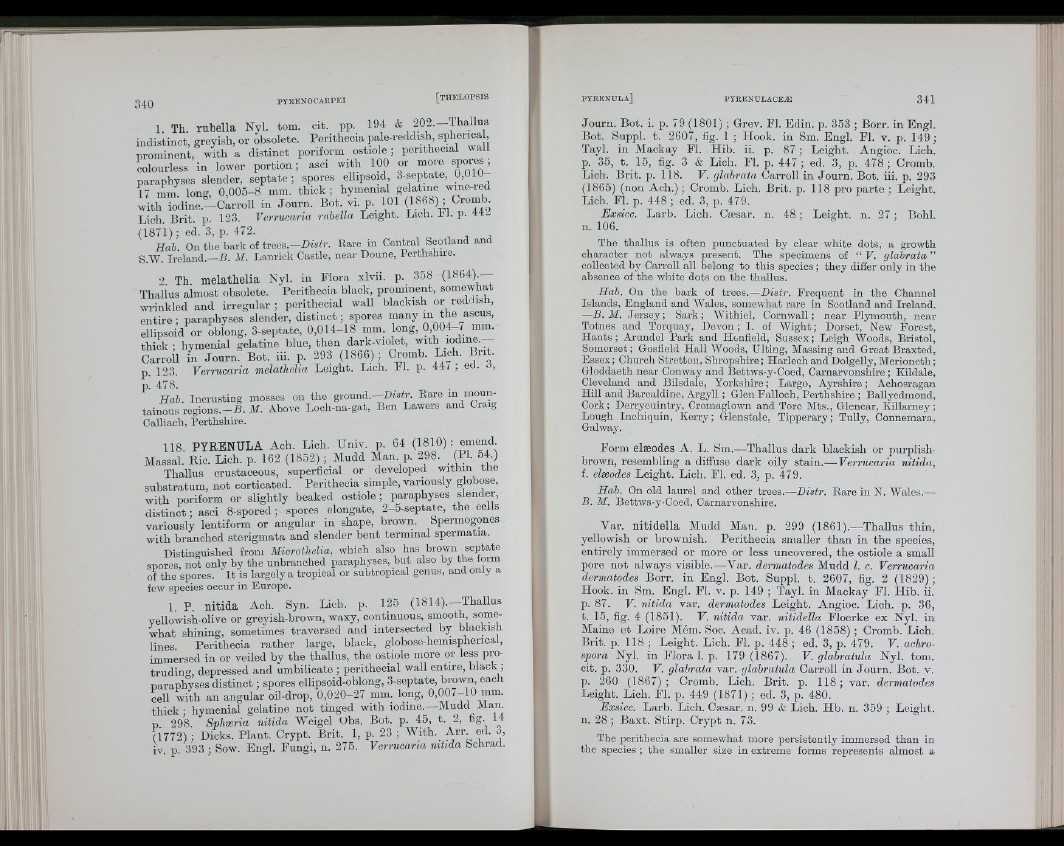
1. Th. rubella Nyl. tom. cit. pp. 194 & 202.-T h a llu s
indistinct, greyish, or obsolete. Perithecia pale-reddish, sphenca ,
prominent, with a distinct poriform ostiole ; peritheciai wall
colourless in lower portion; asci with 100 or more spores^
paraphyses slender, septate; spores ellipsoM, 3-septate, 0,0 iU
17 mm. long, 0,005-8 mm.
with io d in e .-C a rro ll in Journ. Bot vi. p._ 101
Lich. Brit. p. 123. Verrucaria rubella Leight. Lich. h i. p. íA.,
(1871); ed. 3, p. 472. , c
Hab. On the bark of trees.—RisZr. Eare in Central Scotland and
S.AV. Ireland.—R. M. Lanrick Castle, near Donne, Perthshire.
2 Th melathelia Nyl. in Llora xlvii. p. 358 (1 8 6 4 ) --
Thalius almost obsolete. Perithecia black, prominent, somewhat
wrinkled and irregular ; peritheciai wall blackish or reddish,
en tire ; paraphyses slender, d is tin c t; spores m a n y m the ascus,
ellipsoid or oblong, 3-septate, 0,014-18 mm. long, 0,004 7 mm.
thick ; hymenial gelatine blue, then dark-violet, with wdine.—
Carroll in Journ. Bot. iii. p. 293 (1866) ; Cromb. Lich. Brn.
p. 123. Verrucaria melathelia Leight. Lich. Fl. p. 447 , eel. d,
p. 478.
Hab. Incrusting mosses on the gmund.—Distr. Eare in mountainous
re g io n s .-R . M. Above Loch-na-gat, Ben Lawers and Craig
Calliaoh, Perthshire.
118 PYRENULA Ach. Lich. Univ. p. 64 (1810) ; emend.
Massal.' Ric. Lich. p. 162 (1852) ; Mudd Man. p. 298. (PI. 54.)
Thallus crustaceous, superficial or developed within the
substratum, not corticated. Perithecia simple, variously globose,
with poriform or slightly beaked ostiole; paraphyses slender,
distinct ; asci 8-spored ; spores elongate, 2- 5-septate, the cells
variously lentiform or angular in shape, brown. Spermogones
with branched sterigmata and slender bent terminal spermatia.
Distmguished from Uicrothelia, which also has brown septate
spores, not only by the unbranched paraphyses, but also by the iorm
of the spores. I t is largely a tropical or subtropical genus, and only a
few species occur in Europe.
1. P. nitida Ach. Syn. Lich. p. 125 (1814). Thallus
yellowish-olive or greyish-brown, waxy, continuous, smooth, somewhat
shining, sometimes traversed and intersected by blackish
lines Perithecia ra th e r large, black, globose-hemispherical,
immersed in or veiled by the thallus, the ostiole more or less protruding,
depressed and umbilicate ; peritheciai wall entire, blacx ;
paraphyses distinct ; spores ellipsoid-oblong, 3-septate, browi^ eacli
cell with an angular oil-drop, 0,020-27 mm. long, ^’^Oz-lO mm.
th ic k ; hymenial gelatine not tinged with iodine.—Mudd iVLan
p. 298. Sphæria nitida AVeigel Obs. Bot. p. 45, t. 2, hg. 14
(1772) ; Dicks. Plant. Crypt. Brit. 1, p. 23 ; With._ A rr ed. 3,
iv. p. 393 ; Sow. Engl. Fungi, n. 275. Verrucaria nítida Schrad.
Journ. Bot. i. p. 79 (1801) ; Grev. Fl. Edin. p. 353 ; Borr. in Engl.
Bot. Suppl. t. 2607, fig. 1 ; Hook, in Sm. Engl. Fl. v. p. 149;
Tayl. in Mackay Fl. Hib. ii. p. 87 ; Leight. Angioc. Lich.
p. 35, t. 15, fig. 3 & Lich. Fl. p. 447 ; ed. 3, p. 478; Cromb.
Lich. Brit. p. 118. V. glabrata Carroll in Journ. Bot. iii. p. 293
(1865) (non Ach.) ; Cromb. Lich. Brit. p. 118 pro p arte ; Leight.
Lich. Fl. p. 448 ; ed. 3, p. 479.
Exsicc. Larb. Lich. Cæsar. n. 48 ; Leight. n. 27 ; Bohl.
n. 106.
The thallus is often punctuated by clear white dots, a growth
character not always present. The specimens of “ F. glabrata"
collected by Carroll all belong to this species ; they differ only in the
absence of the white dots on the thallus.
Hab. On the bark of trees.—Distr. Frequent in the Channel
Islands, England and AVales, somewhat rare in Scotland and Ireland.
—B .M . Jersey; Sark; AAathiel, Cornwall; near Plymouth, near
Totnes and Torquay, Devon ; I. of AVight ; Dorset, New Forest,
Hants ; Arundel Park and Henfield, Sussex ; Leigh AVoods, Bristol,
Somerset ; Gosfield Hall AVoods, Ulting, Massing and Great Braxted,
Essex ; Church Stretton, Shropshire ; Harlech and Dolgelly, Merioneth ;
Gloddaeth near Conway and Bettws-y-Coed, Carnarvonshire ; Kildale,
Cleveland and Bilsdale, Yorkshire ; Largo, Aj'rshire ; Achosragan
Hill and Barcaldine, Argyll ; Glen Falloch, Perthshire ; Ballyedmond,
Cork; Derryouintry, Cromaglown and Tore Mts., Glencar, Killarney ;
Lough Inchiquin, Kerry; Glenstale, Tipperary; Tully, Connemara,
Galway.
Form elæodes A. L. Sm.—Thallus dark blackish or purplish-
brown, resembling a diffuse dark oily stain.— Verrucaria nitida,
f. elæodes Leight. Lich. Fl. ed. 3, p. 479.
Hab. On old laurel and other trees.—Distr. Rare in N. AVales.—
B. M. Bettws-y-Coed, Carnarvonshire.
Var. nitidella Mudd Man. p. 299 (1861).—Thallus thin,
yellowish or brownish. Perithecia smaller th an in the species,
entirely immersed or more or less uncovered, the ostiole a small
pore not always visible.—Var. dermatodes Mudd I. c. Verrucaria
dermatodes Borr. in Engl. Bot. Suppl. t. 2607, fig. 2 (1829) ;
Hook, in Sm. Engl. Fl. v. p. 149 ; Tayl. in Mackay PI. Hib. ii.
p. 87. F. nitida var. dermatodes Leight. Angioc. Lich. p. 36,
t. 15, fig. 4 (1851). F. nitida var. nitidella Floerke ex Nyl. in
Maine et Loire Mém. Soc. Acad. iv. p. 46 (1858) ; Cromb. Lich.
Brit. p. 118 ; Leight. Lich. Fl. p. 448; ed. 3, p. 479. F. achro-
spora Nyl. in Flora 1. p. 179 (1867). F. glabratula Nyl. tom.
cit. p. 330. F. glabrata var. glabratula Carroll in Journ. Bot. v.
p. 260 (1867); Cromb. Lioh. Brit. p. 118; var. dermatodes
Leight. Lich. Fl. p. 449 (1871); ed. 3, p. 480.
Exsicc. Larb. Lich. Cæsar. n. 99 & Lich. Hb. n. 359 ; Leight.
n. 28; Baxt. Stirp. Crypt n. 73.
The perithecia are somewhat more persistently immersed than in
the species ; the smaller size in extreme forms represents almost a